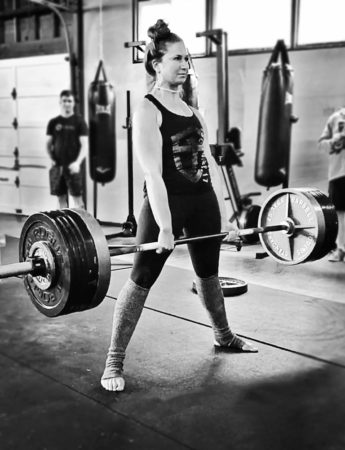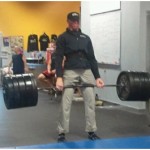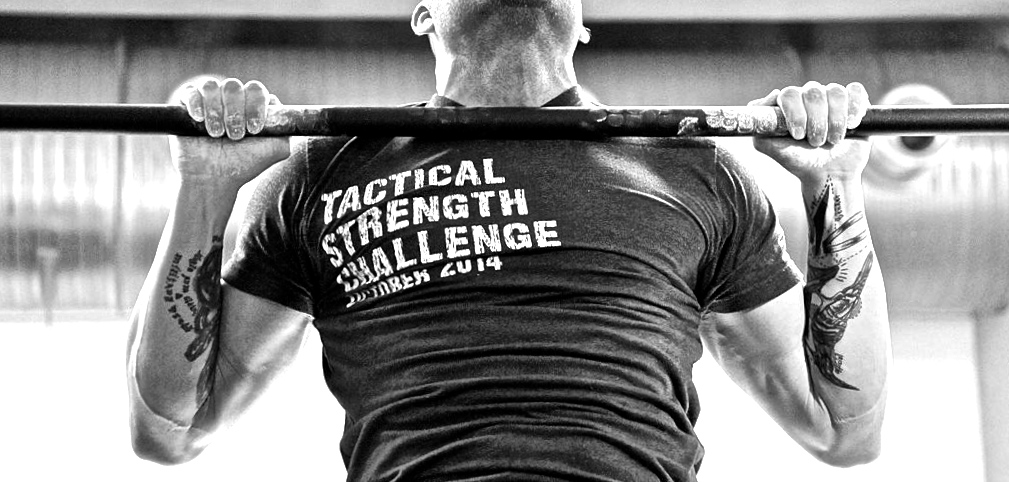The next Tactical Strength Challenge is on October 27, 2018.
Register before August 31, to get your free T-Shirt.
In October of 2017, I competed for the first time in the Women’s Elite Division of StrongFirst’s Tactical Strength Challenge (TSC). I was happy with my results—Deadlift 136kg, Pull-up 7, and Snatch 120—but felt I could improve with some focused, back-to-basics training. With the Spring 2018 TSC on the horizon, I set new goals: Deadlift 160kg, Pull-ups 8, Snatch 125.
Identify the Leaks
My first preparation step was a video review of my lifts, hoping to identify performance-hindering technique leaks. I also sought candid feedback from Pavel and a small group of fellow instructors and friends.* The more input from trusted sources, the better.
 The technique leaks were not hard to identify. On my Deadlift, my grip needed strengthening and I had to master the sumo stance (I had always used a conventional deadlifting stance prior to training for the Fall TSC). On my Pull-ups, I needed to work on sustaining the hollow position for longer sets (I had previously trained in the 1–3 rep range to prepare for Iron Maiden). And on my Snatches, I needed to cinch up tighter in the top position.
The technique leaks were not hard to identify. On my Deadlift, my grip needed strengthening and I had to master the sumo stance (I had always used a conventional deadlifting stance prior to training for the Fall TSC). On my Pull-ups, I needed to work on sustaining the hollow position for longer sets (I had previously trained in the 1–3 rep range to prepare for Iron Maiden). And on my Snatches, I needed to cinch up tighter in the top position.
Plug the Leaks
To address these leaks, I realized I’d need to overcome some training habits: the tendency to go into auto-pilot on lifts I’ve been practicing for years. It’s challenging to maintain intention and attention throughout any complex movement, but focusing on what your body is doing—from the feet up to the head, from setup to park, from start to finish—is essential to safe and efficient execution. When I do find myself on auto-pilot, it’s usually a sign of fatigue, a useful indicator that it’s time to take a break and perhaps even make a change in programming. To avoid auto-pilot, I remind myself to keep a student mindset—to always keep my eyes open for ways to improve, and to make every rep count.
“To adapt to training is to never adapt to training”—Ben Tabachnik
Six weeks prior to the Spring 2018 TSC, I began my new training protocol: heavy swings, heavy snatches, SFG test-weight snatches, a Westside deadlift cycle, Grease-the-Groove (GTG), and additional body-weight trunk work. While similar to how I trained for the Fall TSC, this protocol included important adjustments designed to plug the leaks in my lifts.
Heavy Swings
For example, during my Fall TSC training, I structured heavy swing days according to a plan written by Pavel (5 heavy swings OTM x 12 minutes = 60 swings), modified with a breathing ladder based on Plan Strong principles to vary intensity while maintaining volume. I alternated between two-handed 40kg swings and single-arm 32kg swings. The result looked like this:
Heavy Swing Breathing Ladder
- 2 swings – 2 breaths
- 4 swings – 4 breaths
- 6 swings – 6 breaths
- 8 swings – 8 breaths
- 10 swings – 10 breaths
- Number of swings = 30. Rest 3 minutes, then repeat for a total of 60 swings.
In preparation for the Spring TSC—at the suggestion Hyun Jin—I continued with the single-arm 32kg swings, but instead of the two-handed 40kg swings, I switched to double 20kg KBs swings.
Using double KBs was key to addressing the leaks in all three of my TSC lifts. The separate loads forced me to stabilize and maintain tension in my abs, lats, and glutes—improving my trunk strength and connection. And due to the greater demand for control and coordination, I had to be more intentional on every rep. Finally, it added a layer of strength endurance conditioning which would sustain me through all the event-day demands of the TSC.
Deadlifts
In the Fall 2017 TSC, my grip slipped on the descent of my third DL attempt (145kg), resulting in a missed lift and lower total. For the Spring I followed the same protocol as I had before (a linear Westside Barbell cycle with a 5% increase in intensity each week), but made one key adjustment: I switched to a mixed grip and alternated my grip every rep. Alternating my grip kept me present in every rep, preventing auto-pilot and sharpening my focus on set-up, wedge, and breath.
At Pavel’s suggestion, I also added Pause DLs (lift 2–4 inches off ground, pause for 3 seconds, then finish the lift, at 50% 1RM). This practice allowed me to maintain my wedge and position in the initial DL phase.
Trunk Work and GTG
To strengthen the hollow position on my pull-ups and to cinch up the overhead position of my snatch, I added more trunk work to my training for the Spring TSC. This included crawling every day (varied directions, base positions, and speeds), One-Arm Push-Up practice, One-Arm Planks, One-Arm One-Leg Planks, Val Slide Body Saws, and Double KB Rack Planks. I implemented these after protocol-based sessions if time allowed or included them in my GTG sessions, always making sure—in keeping with StrongFirst principles—to leave a little gas in the tank. Following GTG principles (as outlined here by Craig Marker) helped to keep my body and mind fresh and engaged in every rep.
Rest, Fuel, and Recovery
Throughout my training, I strictly adhered to the rest periods specified in the protocol. This allowed me to produce higher quality reps, refine technique, lift heavier, and safely execute sessions. (Pavel discusses the science of rest intervals here.)
To round out my efforts, I was diligent about fuel and recovery—implementing restorative practices within my daily sessions, getting quality sleep on a regular basis, and soaking my feet in hot Epsom Salt water or floating when my schedule allowed.
“What you will do matters. All you need is to do it.”—Judy Grahn
In April 2018, my preparation and plan came to life.
Having prepared for minimal warm-up in the midst of coaching, judging, and competing, I had my DL lined up with a 160kg (352lb) goal, having lifted that load once before (8 weeks prior to TSC). My lifts were as follows:
DL Warmup:
- 70.4kg (155lb) x 3 (rest 1 min)
- 120.4 kg (265lb) x 1 (rest 1.5 min)
- 136.4 kg (300lb) x 1 (rest 1.5 min)
DL Competition:
- 148kg (325lb) x 1 (rest 3 min)
- 157kg (345lb) x 1 (rest 3 min)
- 166kg (365lb) x 1 (FINAL lift)
Pull-Ups w/5kg: 8 reps
Snatch Test w/20kg: 115 reps

Changing my training protocol paid off. I safely executed a 1RM DL with minimal warm-up, completed a set of loaded pull-ups without an aching shoulder or neck immediately afterward, and stepped into the snatch test with 20kg feeling in control of my position and breathing for the duration of the test.
Fidatevi del Processo—Trust the Process
So what did I learn preparing for the TSC? That making small but well-targeted changes can have a powerful impact. To trust the process of change—to embrace the need for self-critique and to believe in my ability to make necessary adjustments. I was also reminded of the power of our StrongFirst principles, especially the idea that we should always leave something in the tank. And above all, I was reminded of the joy of being a student—of taking input from trusted colleagues and teachers and striving to improve every day, every rep.
*Thanks to Pavel Tsatsouline, Craig Marker, Hyun Jin, and Debbie Hayes.
Always keep my eyes open for ways to improve, and to make every rep count. - Analisa Naldi Share on X
Tactical Strength Challenge: The next TSC will be on October 27th, 2018. Register before August 31st for your T-Shirt.
Related Articles
All-out Competition, or Fat Loss and Status Check: Two other reasons the TSC is Good For You.
Tactical Strength Challenge: Participation, Community, Strength





Great article Analisa!
Amazing detail, thank you! I’m trying to grasp the swing and breathe ladder. Do you swing 2 times put the bell down take 2 breaths, pick the bell back up swing 4 times put the bell down and take 4 breathes. Proceeding until you hit the 10 swing mark? Thank you for any clarification.
Well done and congratulations! I’ll be missing this falls TSC but I have it penciled in for spring 2019. I will defiantly think about my leaks (of which there are many)
Out of curiosity and a desire for self improvement did the breath ladders look like? 2 swings L/R breath or 30 on side 3 min of 30 on the other?
Thanks again for the excellent article.
Great article Analisa! You inspired me to sign up for the fall TSC!
Analisa, thanks for contributing such a detailed explanation of your preparation for the TSC. Including the obstacles you faced and how you overcame them was really educational.
I didn’t really know what the TSC was until I heard someone mention it on the forums the other day. After reading up on the goals for the challenge, I was motivated to make it a goal of mine.
Your article came just in time to help me mentally prepare myself!